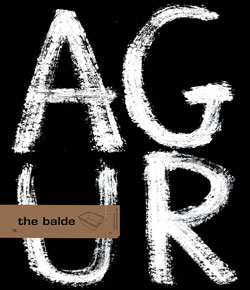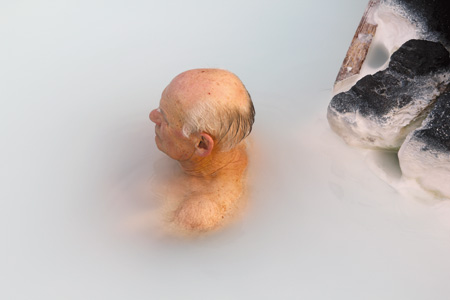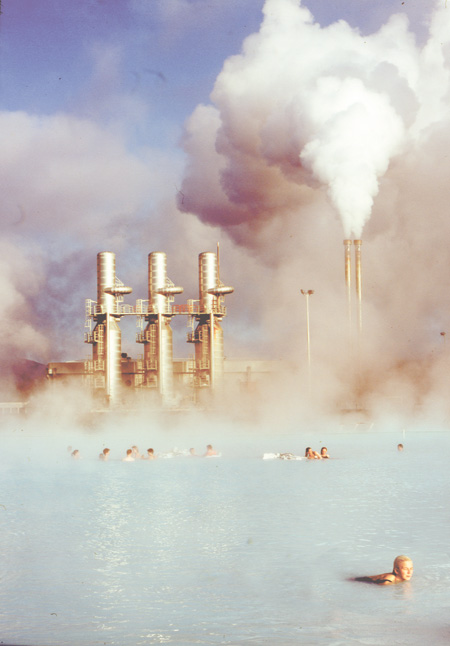light stalker
talking with iñigo salaberria Choosing Iceland for your last work was no coincidence. You lived and worked there 27 years ago. What was it like going back to that special island after so long?
The island’s changed a lot since I lived there. It’s becoming a theme park dedicated to nature. This year a million tourists have visited Iceland for the first time. Four years ago there weren’t even half that many. Before going to Iceland for the first time, I read an interview with Borges in which he said that Icelandic society lived in a glass case, being so far-off and unknown. In 86, when I got there, one of the first things I saw was the prime minister on a billboard encouraging people to use condoms. At that time, AIDS still taboo in Europe. I realised I had reached a different land. Beer was forbidden on Wednesdays and there was no television in July.
That glass case has been broken now and Iceland is in danger of becoming Disneyland. The Vikings have been invaded for the first time, but some of them have started sharpening their axes...
What influence has the past had on the work you have done in Iceland now?
I’ve made two very different videos. The first, “Birta Myrkur II”, is a new version of what I had filmed in the same place 27 years earlier and the second, “Luz a la Deriva”, shows Reykjavik at night.
Until now all my videos had been connected with discovering new places, in a topographical sense, and this is the first time I’ve set up my camera somewhere I know, faded though my memory may be. I wanted to see to what extent my memories had changed. And I’ve realised that what I showed in that perception was not so much a space as my internal time, a look within myself, which came up in front of me like a cliff and which sometimes gave me vertigo. Reality painted my consciousness as if it were a mirror.
How would you define your work in “Birta Myrkur”?
In Icelandic, “Birta” means the light before the sun comes out and “Myrkur” is the light just before night closes in. I chose that name because the nights and days there, compared with the ones we know, have a different rhythm, they merge into each other in a different way from here. It’s a land of extreme contrasts. I went back to Blá Álónid Lake –where, 27 years earlier, I had seen an Icelandic family swimming next to an aluminium factory– to find out if they were still there; although I had filmed there, I wasn’t sure if it hadn’t just been a dream. My doubts were soon cleared up. That evocative, chiselled cliff countryside has become an artificial spa; every day it welcomes hundreds of tourists who don white bathing robes and walk about with glasses in their hands. There were no Icelandic people there.
What work methods did you use? Had you written a script?
No, I don’t write scripts, but I do look around me carefully before I start filming. The way I film has nothing to do with written scripts. I don’t have any previous plans. It’s more to do with light, shadows, movements and people’s gestures. I try to find the right distances. And then, when I have the images, I record the sound separately. I spend days watching and without talking. Then I put it all together, seeing what’s happened and then, perhaps, I take some notes as a sort of script.
The second video you’ve made, ¨Luz a la Deriva¨, was shot in Reykjavik and at night. What do the two films have in common?
As everyone knows, in Iceland a large part of the year is spent in darkness. The first time I was there, I spend a whole winter working in construction in Reykjavik. I used to go for walks at the weekend. When I left the island, the things I remembered were connected with daily life. The shop windows, bars and people I used to see as I walked alo... And they were all lit up by artificial light, as if it were an aquarium. I wanted to relive those sensations in “Luz a la Deriva”.
The advantage of night is that it is like a curtain and it brings out the basic things. But on that black curtain light needs a space and a chosen theme in order to be able to see. The light and shadow which are the basis of cinema, as I was saying about Birta Myrkur, you can see in Georges de la Tour’s painting, Godard’s films from the 80’s, in which the light which illuminates the spaces –candles, lamps or lighting– is included in the composition, in the frame.
Iñigo Salaberria
Iñigo Salaberria (Donostia 1961). He studied cinema history and aesthetics. Before returning to Donostia, he lived and worked in Paris, Lyon, Reykjavik, London and Madrid. He is an expert and precursor in video creation. Although he would never say anything like that. Somebody who loves conversations, he calls his films “videos”. Although I know many artists who work independently, Iñigo Salaberria is the only one I know who makes films to feed his soul. Although he would never say anything like that. His work,
fortunately, has been shown internationally and won various different prizes. Although he would never say anything like that.
Some other works: Disdirak 1992, La Noche navegable 1993, Diario Dogon 1994, Pulso a la materia 2008, Las Horas Contadas 2010.
The island’s changed a lot since I lived there. It’s becoming a theme park dedicated to nature. This year a million tourists have visited Iceland for the first time. Four years ago there weren’t even half that many. Before going to Iceland for the first time, I read an interview with Borges in which he said that Icelandic society lived in a glass case, being so far-off and unknown. In 86, when I got there, one of the first things I saw was the prime minister on a billboard encouraging people to use condoms. At that time, AIDS still taboo in Europe. I realised I had reached a different land. Beer was forbidden on Wednesdays and there was no television in July.
That glass case has been broken now and Iceland is in danger of becoming Disneyland. The Vikings have been invaded for the first time, but some of them have started sharpening their axes...
What influence has the past had on the work you have done in Iceland now?
I’ve made two very different videos. The first, “Birta Myrkur II”, is a new version of what I had filmed in the same place 27 years earlier and the second, “Luz a la Deriva”, shows Reykjavik at night.
Until now all my videos had been connected with discovering new places, in a topographical sense, and this is the first time I’ve set up my camera somewhere I know, faded though my memory may be. I wanted to see to what extent my memories had changed. And I’ve realised that what I showed in that perception was not so much a space as my internal time, a look within myself, which came up in front of me like a cliff and which sometimes gave me vertigo. Reality painted my consciousness as if it were a mirror.
How would you define your work in “Birta Myrkur”?
In Icelandic, “Birta” means the light before the sun comes out and “Myrkur” is the light just before night closes in. I chose that name because the nights and days there, compared with the ones we know, have a different rhythm, they merge into each other in a different way from here. It’s a land of extreme contrasts. I went back to Blá Álónid Lake –where, 27 years earlier, I had seen an Icelandic family swimming next to an aluminium factory– to find out if they were still there; although I had filmed there, I wasn’t sure if it hadn’t just been a dream. My doubts were soon cleared up. That evocative, chiselled cliff countryside has become an artificial spa; every day it welcomes hundreds of tourists who don white bathing robes and walk about with glasses in their hands. There were no Icelandic people there.
What work methods did you use? Had you written a script?
No, I don’t write scripts, but I do look around me carefully before I start filming. The way I film has nothing to do with written scripts. I don’t have any previous plans. It’s more to do with light, shadows, movements and people’s gestures. I try to find the right distances. And then, when I have the images, I record the sound separately. I spend days watching and without talking. Then I put it all together, seeing what’s happened and then, perhaps, I take some notes as a sort of script.
The second video you’ve made, ¨Luz a la Deriva¨, was shot in Reykjavik and at night. What do the two films have in common?
As everyone knows, in Iceland a large part of the year is spent in darkness. The first time I was there, I spend a whole winter working in construction in Reykjavik. I used to go for walks at the weekend. When I left the island, the things I remembered were connected with daily life. The shop windows, bars and people I used to see as I walked alo... And they were all lit up by artificial light, as if it were an aquarium. I wanted to relive those sensations in “Luz a la Deriva”.
The advantage of night is that it is like a curtain and it brings out the basic things. But on that black curtain light needs a space and a chosen theme in order to be able to see. The light and shadow which are the basis of cinema, as I was saying about Birta Myrkur, you can see in Georges de la Tour’s painting, Godard’s films from the 80’s, in which the light which illuminates the spaces –candles, lamps or lighting– is included in the composition, in the frame.
Iñigo Salaberria
Iñigo Salaberria (Donostia 1961). He studied cinema history and aesthetics. Before returning to Donostia, he lived and worked in Paris, Lyon, Reykjavik, London and Madrid. He is an expert and precursor in video creation. Although he would never say anything like that. Somebody who loves conversations, he calls his films “videos”. Although I know many artists who work independently, Iñigo Salaberria is the only one I know who makes films to feed his soul. Although he would never say anything like that. His work,
fortunately, has been shown internationally and won various different prizes. Although he would never say anything like that.
Some other works: Disdirak 1992, La Noche navegable 1993, Diario Dogon 1994, Pulso a la materia 2008, Las Horas Contadas 2010.




